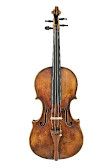Domenico Montagnana
1686–1750Domenico Montagnana ranks as one of the most accomplished masters of the Venetian school. Montagnana was born on June 27, 1686, in Lendinara, the seventh child of a shoemaker. His mother died in 1695, whereupon the family moved to Venice. The evidence suggests that he trained with Matteo Sellas from 1702. He opened up his own shop in 1712, and married Caterina Berti in 1717, a union that produced five daughters. At the outset, Montagnana’s income was so low that he had to apply for a deferral of his tax debt in 1725. But by and by, the music scene in Venice flourished, benefiting Montagnana as well. He soon became the leading violinmaker of the lagoon city of Venice. Several institutions ordered instruments from Montagnana, for example the music school Ospedale della Pietà, which had achieved fame through Antonio Vivaldi. Montagnana’s reputation grew well beyond Venice, with orders coming in from as far as Rome and Salzburg. His wealth allowed him to provide his daughters with large dowries and to invest in gold coins and real estate. After his death on March 6, 1750, his estate was estimated at 22,320 lire – quite a considerable fortune considering that a newly built violin cost roughly 235 lire at the time.
Today, Montagnana is known first and foremost for the superior quality of his cellos, which possess both an excellent tone and a rich sound volume. His violins are very sought after as well. Little is known about his work until 1720; it is assumed that he started out mainly doing repairs. His early works clearly reflect Stainer’s influence, for example high arching of the belly and back. Later, Montagnana adopted a larger model with flatter arching. This transition went hand in hand with a change in the maker’s mark: Montagnana adopted the name “Cremona” as the sign of his house and added “Sub Signum Cremonæ” (at the sign of Cremona) to his labels from then on. After Montagnana’s death, Giorgio Serafin became the owner of the workshop in partnership with Montagnana’s daughters.

